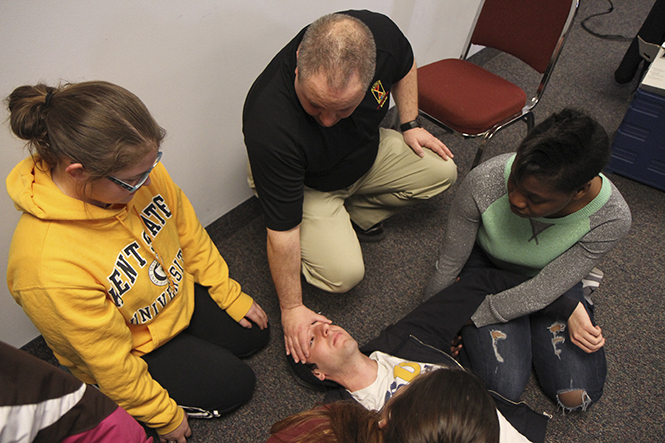A.L.i.C.E. training preps Kent State staff for active-shooter crises
May 1, 2013
During a crisis-training workshop held in a conference room on the 3rd floor of the Student Center, a group of about 30 faculty and staff members made small talk as the clock reached the 1:30 p.m. starting time. Soon, the instructor, Renee Romine, greeted the class by asking, “What are all the available items in this room that could be used as weapons?”
After university professors and staff members yelled out, “keys,” “coffee” and “chairs,” the room grew quiet but was soon jolted when Romine loudly screamed “Ahh!” This demonstrated how yelling at an active shooter can be a distraction, diminishing his ability to shoot accurately.
After the participants composed themselves from the startling, humorous screaming demonstration, Romine suggested a few additional survival tactics. Throwing books or other items toward the shooter’s face can cause him to lose focus.
Barricading the door using belts to tie the door handle to heavy objects could deter the shooter from entering, or provide whoever is inside time to escape safely out a window.
“This is one time in our lives when it’s OK to be aggressive,” Romine said. “It’s OK to save your life.”
Romine, senior training and development specialist from the Human Resources Department, invited two able-bodied men to the front of the room. Posing as a shooter, she challenged them to “take her down.”
They began by throwing golden loofah sponges and rubber balls toward her face to distract her. Once distracted, they attempted to restrain her to the floor but failed, much to the amusement of the audience.
After Romine detailed a specific technique from the A.L.i.C.E. program, they promptly felled her by interlocking their arms with hers and dropping to the floor, using their combined weight to their advantage.
As politicians battle over the causes of mass shootings, law enforcement is arming potential victims with a survival mentality.
A.L.i.C.E., which stands for Alert, Lockdown, Inform, Counter and Evacuate, is a crisis-training program has been implemented in educational institutions, hospitals and other businesses throughout the country. It is designed to provide participants with a survival instinct and physical tactics to counter an active shooter.
After news of the 1999 Columbine shooting in Littleton, Colo., where two students killed 13 people and wounded 24 before taking their own lives, one law enforcement official in the Dallas area crafted a program of tactics to further the probability of survival in similar crises.
“When Columbine occurred, that was our dose of reality that we’re not going to be able to get there in time to make a difference,” said Greg Crane, founder of the A.L.i.C.E. program.
Subsequent to the Columbine incident, Crane’s wife, Lisa, an elementary school principal, informed him that the standard procedure at her school for mass shootings was a “code red” response — to go into lockdown.
“I just didn’t feel that was adequate,” Crane said.
After years of experience in law enforcement, Crane recognized that individuals were not safe following this passive-response lockdown strategy. This led to Crane, along with input from his wife and fellow SWAT member Allen Hill, developing A.L.i.C.E., which continues to increase in popularity across the nation.
The primary objective of the program is to promote self-defense techniques without restricting the option to escape.
“That’s one of my concerns with a strict lockdown program, is you’re limiting people’s options,” he said. “If you only give people one strategy, you’ve always got to hope that it’s the right strategy, and we feel that is just inadequate planning and preparation.”
Instead, the founders of the program pride themselves on developing a more versatile plan.
“Every one of these events is unique,” Crane said. “You can’t build a one-size-fits-all plan to ‘How do you survive an active shooter?’ That’s why the plan has to be more conceptual. It has to be options based. There has to be empowerment by the people under attack to make decisions for themselves.”
Crane explained that during the 2007 Virginia Tech shooting, “the rooms that did nothing but maintain a passive posture, the outcome was horrific, but in rooms where they did something to try and help themselves, they mitigated the casualties significantly.”
Kent State, the second largest university in Ohio, is one of many institutions in 28 states that have adopted the A.L.i.C.E. program. More than 100 school districts in Ohio use the program, and about 1.6 million participants in educational institutions have completed the training.
The Department of Public Safety partnered with the Division of Human Resources in 2009 to introduce the program to the Kent State community. Currently, six university employees are trained to instruct these 90-minute crisis-training programs.
After 10 years of training, Crane said it is very rewarding to provide people with information that could save their lives. He has received many messages from past trainees throughout the years, thanking him for the training that helped them make key decisions in stressful situations in their lives. Crane explained how moments like these are what make the program worthwhile.
“That’s what keeps you traveling and keeps you going is that people want the information,” he said. “They need the information, and we’re trying to provide it.”
Contact Amanda Crumm at [email protected].

























